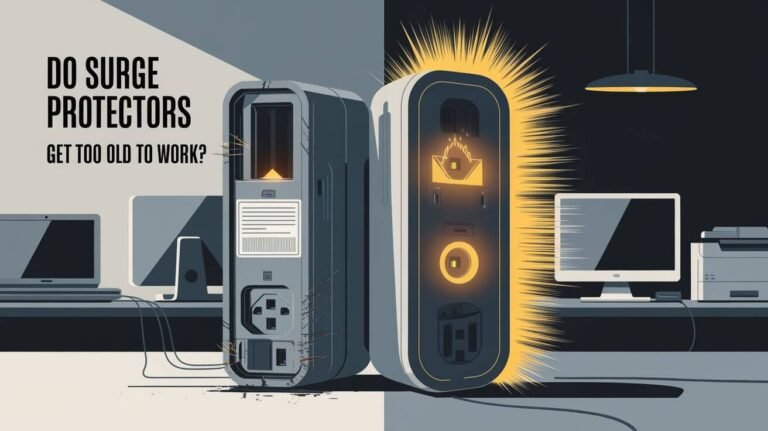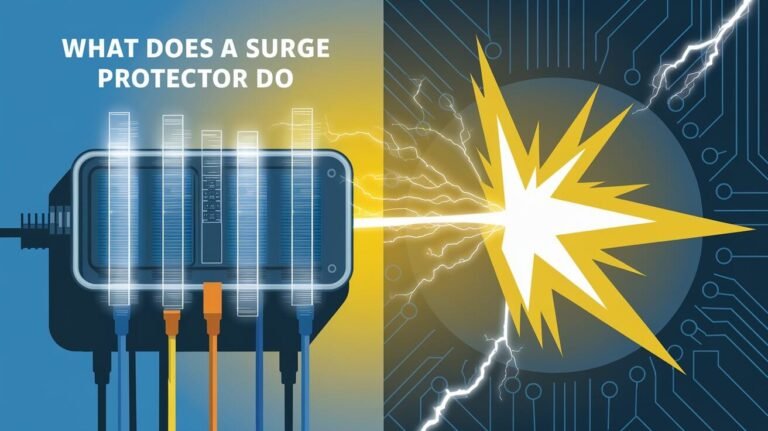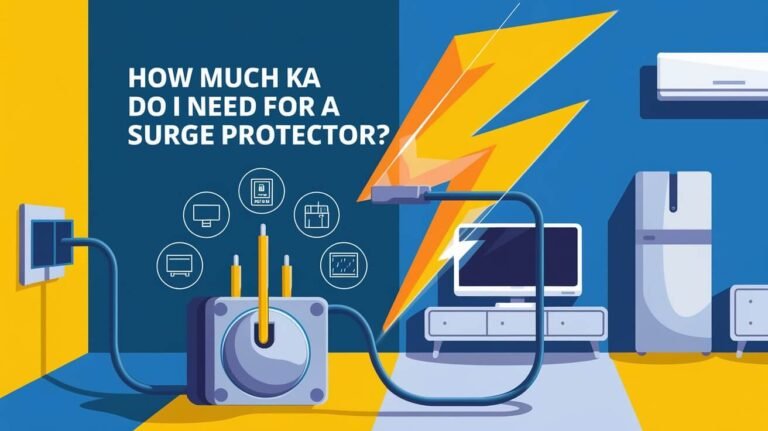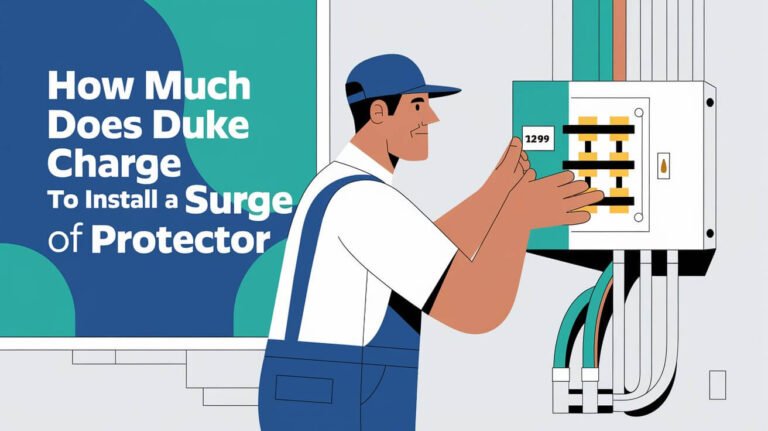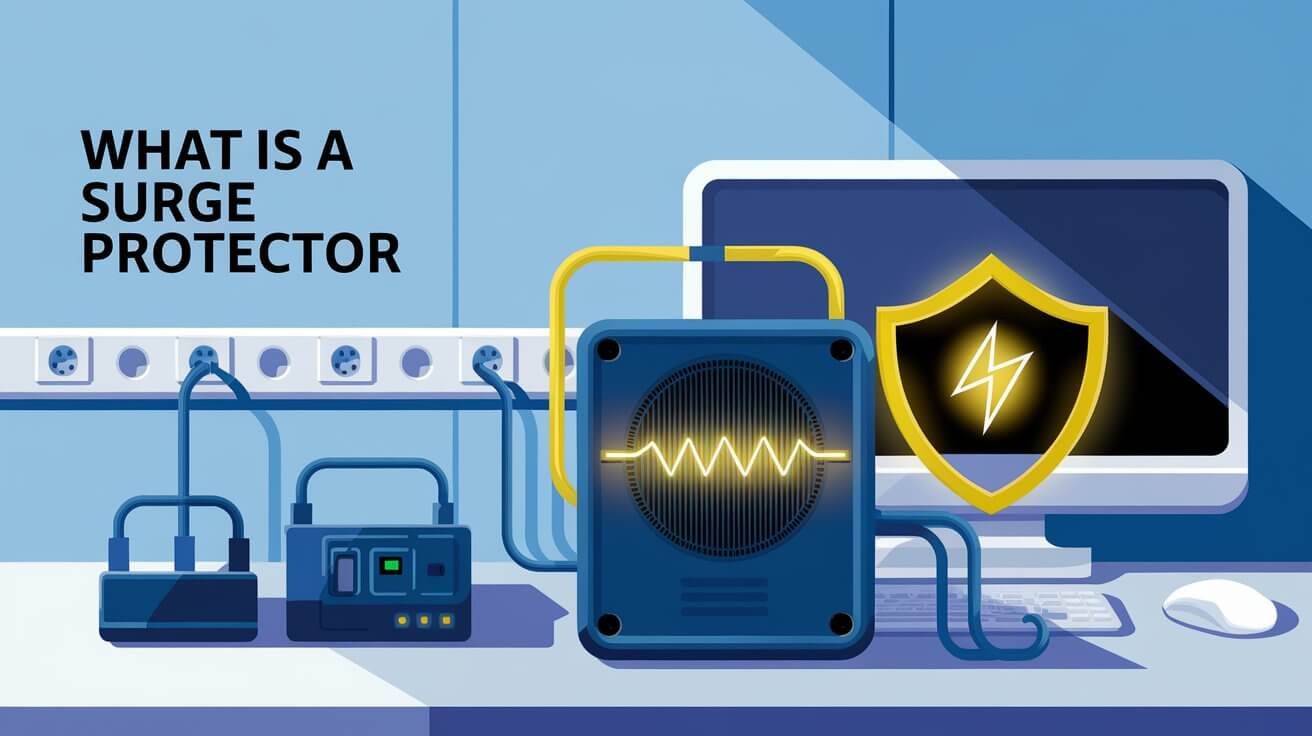
A surge protector is a key electrical safety device. It keeps electronic devices safe from sudden power spikes. These spikes can come from lightning, grid issues, or other external factors.
Knowing what a surge protector is helps us see its value at home and in offices. It’s vital for protecting our gadgets from damage.
In the U.S., surge protectors are essential for keeping electronic devices working well. They act as a shield against power surges. This helps prevent damage and reduces fire risks.
By using a surge protector, you can rest easy. Your devices are safe from sudden power spikes.
The Basic Function of Surge Protectors
Surge protectors are key in keeping electronic devices safe from power spikes and voltage changes. They work by regulating voltage, keeping the power supply steady and consistent. This is done through special components that absorb and divert extra energy.
Surge protectors use various methods to protect devices from power spikes. They include metal oxide varistors (MOVs) and gas discharge tubes (GDTs). These help to soak up and redirect extra energy. This way, surge protectors prevent damage, reduce data loss, and avoid system downtime.
Voltage Regulation Mechanisms
Voltage regulation is a vital part of surge protectors. These mechanisms control the power flow to devices, keeping the voltage safe and stable. By doing this, surge protectors prevent damage and lower the chance of power-related issues.
Protection Against Power Spikes
Surge protectors are designed to handle power spikes. They absorb and divert extra energy, protecting devices and preventing data loss. This is very important in places with lots of thunderstorms or power grid issues.
Core Components and Design
The heart of a surge protector includes special components like MOVs and GDTs, along with the circuit board and wiring. The design must be strong to handle high energy levels and offer good protection. With quality components and a solid design, surge protectors keep devices safe and working.
Power Surge Types and Their Impact
Power surges come from different sources like lightning, power grid issues, and internal problems. These surges can harm electronic devices, causing damage and disrupting our daily lives. For instance, lightning can send powerful electrical surges through power lines, damaging devices connected to the grid.
Power grid fluctuations happen when there’s a change in electricity demand or supply. These changes can lead to voltage spikes, which are bad for sensitive electronics. Internal surges, caused by appliances like refrigerators and air conditioners, can also damage devices on the same circuit.
Some common types of power surges include:
- Electrical storms, which can cause lightning strikes and subsequent power surges
- Grid switching, which can cause power grid fluctuations and voltage spikes
- Appliance malfunctions, which can cause internal surges and damage to connected devices
To protect against these surges, using surge protectors is key. They can absorb or divert excess energy. Knowing about different surges and their causes helps us take steps to protect our electronics.
| Type of Surge | Cause | Effect |
|---|---|---|
| Lightning Strike | Natural electrical discharge | Powerful electrical surge that can damage devices |
| Power Grid Fluctuation | Changes in demand or supply of electricity | Voltage spikes that can harm sensitive electronic equipment |
| Internal Surge | High-powered appliances | Damage to devices connected to the same circuit |
Essential Components of Quality Surge Protectors
Several key components make a surge protector effective. Knowing these parts is key to picking a good surge protector. The joule rating shows how much energy a surge protector can handle before failing. A higher joule rating means better protection for your devices.
Clamping voltage is also important. It’s the voltage at which the surge protector starts protecting your devices. A lower clamping voltage means quicker protection. The surge protector’s response time is critical too. It shows how fast the protector can react to a voltage spike.
Joule Ratings Explained
Joule ratings measure a surge protector’s energy absorption. A higher rating means better protection. For instance, a 1000 joule protector can handle more energy than a 500 joule one.
Clamping Voltage Specifications
Clamping voltage varies among surge protectors. A lower voltage is better for protecting your devices. Here’s a table showing typical clamping voltages for different surge protectors:
| Surge Protector Type | Clamping Voltage |
|---|---|
| Basic Surge Protector | 400-500 volts |
| Mid-Range Surge Protector | 300-400 volts |
| High-End Surge Protector | 200-300 volts |
Response Time Measurements
The response time of a surge protector is very important. A quicker response time means faster protection against voltage spikes. When choosing a surge protector, look for one with a fast response time, usually measured in nanoseconds.
Common Surge Protector Features
When picking a surge protector, look at the features that boost protection and ease. Indicator lights show the surge protector’s status, like if it’s on or if there’s a problem. These lights help you know your devices are safe from power spikes.
USB ports are another great feature. They let you charge your gadgets right from the surge protector. This is handy for charging phones, tablets, or other mobile devices. Choose surge protectors with many USB ports to charge more than one device at once.
Some surge protectors also guard against surges through cable or satellite connections. This is key for keeping TVs and computers safe. Other features to think about include:
- Ethernet protection for network connections
- Automatic shutdown during a power surge
- Alert systems for warning you of issues
Looking at these features and their benefits, you can pick a surge protector that fits your needs. It should offer full protection for your devices.
Surge Protector vs Power Strip Differences
Protecting your electronic devices is key. Knowing the difference between surge protectors and power strips is important. A comparison can guide your choice. Look for UL certification, which shows the device meets safety standards.
Surge protectors can handle power spikes better than power strips. They are built stronger and might have extra features like LED lights and reset buttons.
Safety Certifications
UL certification is a must. It means the product has passed strict safety tests. This is vital for protecting your devices from power surges.
Protection Capabilities
Surge protectors offer better protection against power spikes. They can handle excess energy, keeping your devices safe. Power strips, on the other hand, are better for non-essential items.
Design Elements
Think about what design features you need. Surge protectors might be more compact, while power strips have longer cords and more outlets. Choose based on your needs and protection level required.
comparing power strips can help you pick the right one. Consider safety, protection, and design to ensure your devices are safe from power surges.
Smart Home Integration and Modern Surge Protection
Smart surge protectors have changed how we protect our homes from power surges. Now, we can watch and control our energy use from anywhere. This is great for those who want to save on their energy bills.
These devices also track energy use in real-time. This lets homeowners see where they can use less energy. It helps lower bills and is better for the planet. Some smart surge protectors have cool features like:
- Remote monitoring and control through mobile apps
- Energy usage tracking and reporting
- Customizable notifications for power surges and outages
- Integration with voice assistants for hands-free control
When picking a smart surge protector, think about its app features and energy tracking. Look for well-known brands that offer detailed reports and alerts you can set up yourself. A smart surge protector keeps your devices safe and helps you use energy wisely.
| Feature | Description |
|---|---|
| App-controlled protection | Remote monitoring and control of energy usage |
| Energy monitoring | Real-time tracking of energy consumption |
| Customizable notifications | Personalized alerts for power surges and outages |
Maintenance and Replacement Guidelines
To keep your surge protector working well, it’s key to know how long it lasts and check it often. The lifespan of a surge protector depends on how much you use it and your environment. Most have wear indicators that tell you when it’s time to get a new one. Regularly checking these indicators helps you know when to replace it and keeps your devices safe.
Some common signs of wear and damage include:
- Visible burn marks or melting on the device
- Cracked or broken plugs and outlets
- Frayed or damaged cords
- Unusual odors or sounds coming from the device
How often you should replace your surge protector depends on its joule rating, clamping voltage, and response time. It’s usually best to replace them every 2-5 years or when you see signs of wear. By following these tips and keeping an eye on your surge protector’s condition, you can avoid power surges and protect your devices.
| Surge Protector Type | Average Lifespan | Replacement Frequency |
|---|---|---|
| Basic Surge Protector | 2-3 years | Every 2-3 years or when signs of wear appear |
| Advanced Surge Protector | 5-7 years | Every 5-7 years or when signs of wear appear |
Risk Prevention and Safety Standards
To keep electrical systems safe, following industry standards is key. NEMA (National Electrical Manufacturers Association) sets these guidelines. They ensure electrical equipment, like surge protectors, are installed and designed safely.
When picking a surge protector, look for certification. This shows it can handle power surges and spikes well.
Proper installation and use are also important. Here are some tips to keep in mind:
- Always follow the manufacturer’s instructions for installation and use.
- Choose a surge protector that meets your specific needs, taking into account the type of equipment you want to protect and the level of protection required.
- Regularly inspect your surge protector for signs of wear and damage, and replace it if necessary.
Following these guidelines and choosing a surge protector that meets NEMA standards and has undergone surge protector certification, you can help prevent electrical accidents. This ensures your equipment operates safely. Remember, electrical safety is a top priority. Taking the necessary precautions can protect you and your property from power surges and electrical faults.
| Standard | Description |
|---|---|
| NEMA standards | Guidelines for the safe design and installation of electrical equipment |
| Surge protector certification | Verification of a surge protector’s ability to protect against power surges and spikes |
Bottom Line
Surge protectors are key to keeping your electronic devices safe. They protect against power surges and spikes. This means your gadgets, like TVs and computers, will work well for longer.
A single power surge can damage your tech and cost a lot to fix. So, it’s vital to have good surge protection. This keeps your devices safe from harm.
When picking a surge protector, look for important features. These include high joule ratings, good clamping voltage, and fast response times. These help defend against electrical issues.
Choosing the right surge protector gives you peace of mind. Your devices will be safe from damage. This lets you enjoy your tech without worry.
Now, check if your surge protection is up to date. Make sure it fits your smart home or office needs. Being proactive keeps your tech safe and running smoothly for years.
Frequently Asked Questions
What is the purpose of a surge protector?
A surge protector keeps your electronics safe from sudden power spikes. It keeps the power steady and protects your devices from damage.
How do surge protectors work?
Surge protectors use special mechanisms to keep the power steady. They absorb excess energy from power spikes, protecting your devices. Key parts like metal oxide varistors (MOVs) play a big role in this.
What types of power surges can affect electronic devices?
Many things can cause power surges, like lightning, power grid issues, and even appliances. These sudden power increases can harm or destroy your electronics if not protected.
What features should I look for in a quality surge protector?
Look for a surge protector with a high joule rating and low clamping voltage. A fast response time is also important. These features help protect against power spikes effectively.
What additional features can surge protectors offer?
Today’s surge protectors come with extra features like lights and USB ports. They also protect your internet and Ethernet connections. These features make them more useful and protective.
How do surge protectors differ from power strips?
Surge protectors and power strips look similar but serve different purposes. Protectors are made to handle power surges, while strips just extend outlets. Protectors offer better safety.
How can I integrate surge protection into my smart home setup?
Modern surge protectors fit well with smart homes. They have features like app control and energy monitoring. This lets you manage your protection and energy use easily.
How do I maintain and replace my surge protector?
Check your surge protector often for damage. It might need to be replaced every few years, depending on use. Replacing it regularly keeps you safe from electrical dangers.
What safety standards should I consider when using surge protectors?
Make sure your surge protector meets safety standards, like those from NEMA. Following these guidelines ensures your protector works well and safely.

